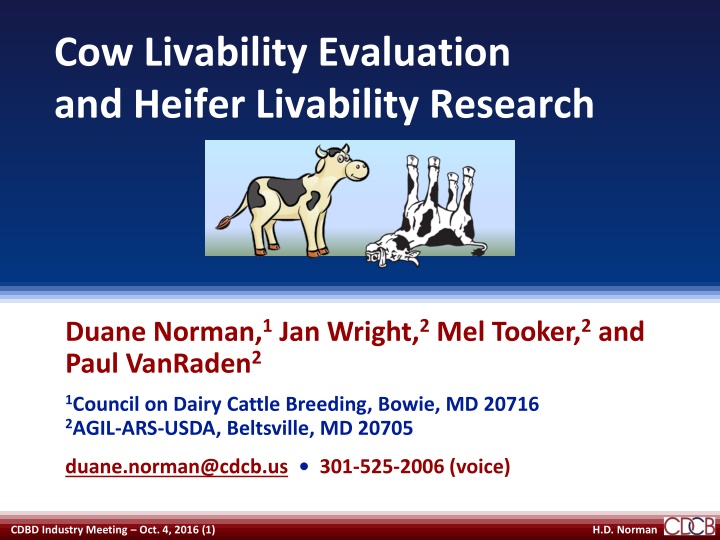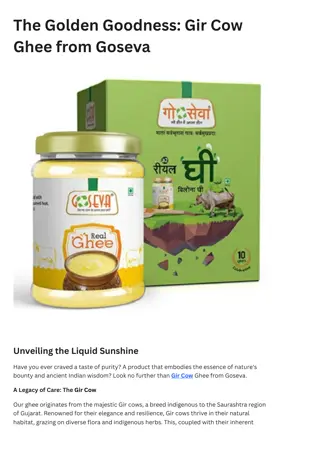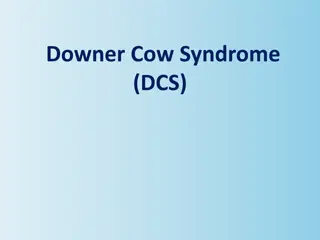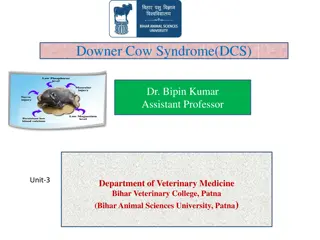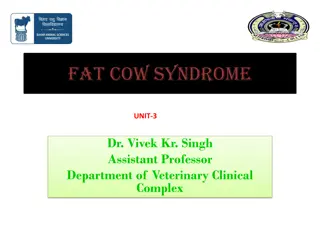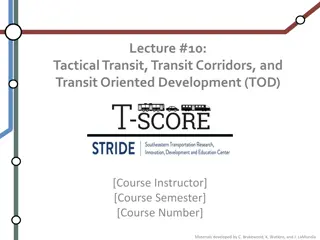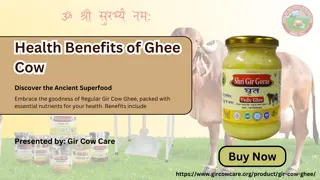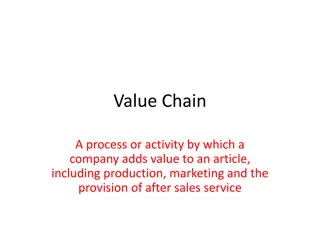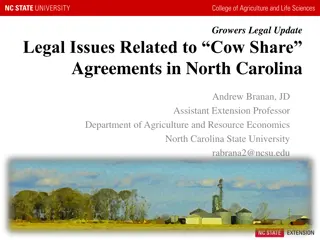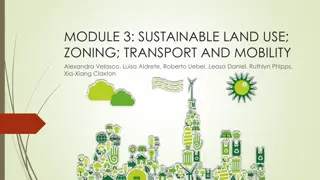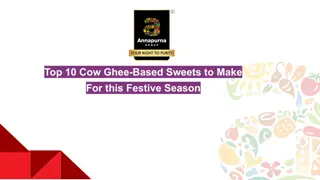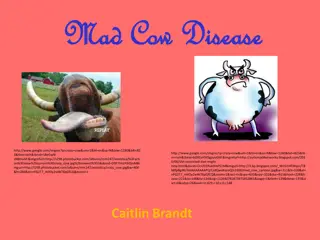Advances in Cow Livability Research
Genetic evaluations for cow livability and heifer livability have shown significant progress in improving animal health over the years. The research, presented at the CDBD Industry Meeting in 2016, highlights the importance of genetic trends in enhancing productive life and somatic cell score in Holstein cattle. The introduction of new tools, such as official genetic evaluations for cow livability, demonstrates a proactive approach towards ensuring healthier and more profitable dairy herds.
Download Presentation

Please find below an Image/Link to download the presentation.
The content on the website is provided AS IS for your information and personal use only. It may not be sold, licensed, or shared on other websites without obtaining consent from the author.If you encounter any issues during the download, it is possible that the publisher has removed the file from their server.
You are allowed to download the files provided on this website for personal or commercial use, subject to the condition that they are used lawfully. All files are the property of their respective owners.
The content on the website is provided AS IS for your information and personal use only. It may not be sold, licensed, or shared on other websites without obtaining consent from the author.
E N D
Presentation Transcript
Cow Livability Evaluation and Heifer Livability Research Duane Norman,1Jan Wright,2Mel Tooker,2and Paul VanRaden2 1Council on Dairy Cattle Breeding, Bowie, MD 20716 2AGIL-ARS-USDA, Beltsville, MD 20705 duane.norman@cdcb.us 301-525-2006 (voice) CDBD Industry Meeting Oct. 4, 2016 (1) H.D. Norman
Background l Genetic evaluations for productive life (PL) were published by AIPL in 1994. l PL was a valuable asset for obtaining healthier animals. l WHY: Selection for PL ended and reversed a genetic decline in pregnancy rate (16 percentage points) that occurred over 5 decades. CDBD Industry Meeting Oct. 4, 2016 (2) H.D. Norman
Genetic trend for cow & sire DPR Holstein CDBD Industry Meeting Oct. 4, 2016 (3) H.D. Norman
More background l Genetic evaluations for somatic cell score (SCS) were published by AIPL in 1994. Unfavorable genetic changes in SCS due to higher milk yields also ended after SCS evaluations were first published. CDBD Industry Meeting Oct. 4, 2016 (4) H.D. Norman
Genetic trend for cow & sire SCS Holstein CDBD Industry Meeting Oct. 4, 2016 (5) H.D. Norman
More background l 1994 was a very good year but why did it take 8 years to make any progress? l NORMAN PROCLAMATION: We ve made progress in improving animal health but the public doesn t know about it? w At least 99 out of 100 non-dairy folks wouldn t know because we ve never told them. CDBD Industry Meeting Oct. 4, 2016 (6) H.D. Norman
Moving on to 2016 l There is a new tool that can and will improve animal health. l CDCB published official genetic evaluations (PTAs) for cow livability in the August 2016 run. l Cow livability is a prediction of a cow s ability to remain alive while in the herd. l In contrast, PL is a prediction of how long a cow is expected to remain in the milking herd (before being culled or dying). CDBD Industry Meeting Oct. 4, 2016 (7) H.D. Norman
Deep thoughts l Cow livability is just one of several traits that determine PL. l However, it has a high impact on profit and was not accounted for before. l When a cow is sold for dairy or beef (called voluntary culling), the sales income is returned to the owner; if a cow dies or is euthanized, there is no income. l Cattle with positive livability permits more voluntary culling, so producers end up with more animals with other traits they like. CDBD Industry Meeting Oct. 4, 2016 (8) H.D. Norman
Deeper thoughts l Knowing which cows are predicted to remain in the herd the longest is not the entire story. l Additional benefit comes from knowing which cows are likely to produce sales income at disposal. l These predictions should be incorporated into the breeding program through the lifetime merit indexes. Once the cow is already in the herd, part of the value of knowing this is gone. CDBD Industry Meeting Oct. 4, 2016 (9) H.D. Norman
Data and death rate l Reasons for disposal have been reported and stored in DHI records since 1970: 92 million records for 32 million cows. l Death loss per lactation averages 6%. U.S. Holsteins average 2.8 lactations; 17% of them die instead of being sold. l Death rate is higher in later than in earlier lactations. CDBD Industry Meeting Oct. 4, 2016 (10) H.D. Norman
Death and dollars l The lost disposal income from cows that die in the U.S. is about $670 million per year. w 17% of 9.2 million cows $1200/cow 2.8 lactations = $670 million/year. l ONE MORE DEEP THOUGHT: Isn t it interesting that one new trait that is expected to receive 7% of the emphasis in NM$ can have this kind of financial impact on dairy producers bottom line? or should I say the consumers spending on dairy products? CDBD Industry Meeting Oct. 4, 2016 (11) H.D. Norman
Cow livability evaluation l U.S. is the first country to evaluate livability l Evaluation method w Multibreed model including heterosis and inbreeding w Multitrait model with PL by lactation using similar edits and same software as other traits Lactation PL not reported, only lifetime PL l Heritability of 1.3% (Miller et al., JDS, 2008). l Using genomics, predictions have high accuracy in spite of low heritability. Reliability for young genomic tested bulls without daughters averaged 56%. CDBD Industry Meeting Oct. 4, 2016 (12) H.D. Norman
And the good news is l Genetic correlation with PL is 0.50, which differs enough from 1.0 so that selecting for cow livability will be effective beyond that achieved by selecting for PL. l Since 17% of the cows die sometime while in the milking herd, 83% live until sold. CDBD Industry Meeting Oct. 4, 2016 (13) H.D. Norman
Interpreting PTA for cow livability l If Bull A has a PTA for cow livability of 2.0, it means about 85% (83% + 2.0%) of his daughters will remain alive to be sold from the milking herd. l If Bull B has a PTA for cow livability of 3.0%, he will have 80% (83% 3.0%) of his daughters remaining alive to be sold. l Bull B is predicted to have 5% more of his daughters that die, bringing a loss of $60 per animal (5% $1200). CDBD Industry Meeting Oct. 4, 2016 (14) H.D. Norman
PTA correlations of livability with other traits Bulls with 50 daughters, 50% reliability for cow livability, and birth year after 1990: Trait Milk Fat Protein PL SCS DPR CCR HCR Holstein 0.09 0.21 0.16 0.70 0.28 0.40 0.40 0.28 Jersey 0.08 0.01 0.01 0.54 0.07 0.54 0.33 0.32 Bulls (no.) 45,840 3,893 CDBD Industry Meeting Oct. 4, 2016 (15) H.D. Norman
Genetic trend for cow & sire livability Holstein CDBD Industry Meeting Oct. 4, 2016 (16) H.D. Norman
Genetic trends for cow livability All breeds CDBD Industry Meeting Oct. 4, 2016 (17) H.D. Norman
New research heifer livability l Extracted data from CDCB database. w 10,976,884 heifer births w 6,343,337 heifers born in years 2001 2013 w 495,282 with left herd codes: (2 = sold to another dairy; 4 = sold for reproduction; 5 = sold for any other reason; 6 = died) l >99% of data came from one source (Dairy Records Management Systems, NC and IA) CDBD Industry Meeting Oct. 4, 2016 (18) H.D. Norman
Heifer livability edits l Some farms only use termination codes for heifers to report deaths (100%); others farms do not report termination codes for heifers (0%). w Edits required herds to have a minimum of 2% heifer deaths and a maximum of 25%. l Heifers that calve are coded as alive (100%). CDBD Industry Meeting Oct. 4, 2016 (19) H.D. Norman
Heifer livability edits (continued) l Heifers dying within 48 hours after birth are not included in heifer livability. w These are reported as stillbirths; we avoid double counting. l Heifers with evidence that they re alive at 18 months get full credit (100%) in heifer livability. w Older losses often associated with 1st calving. l Based on edits, livability scored as 100 or 0%. CDBD Industry Meeting Oct. 4, 2016 (20) H.D. Norman
Heifer livability results l 23% of reported heifer deaths occur during first 8 weeks. l 33% of deaths recorded occurred during and after 18 and were not used. It is believed this is primarily producers catching up with their inventory at calving time. l Edited heifer livability averaged 95%. l Heritability of 0.004 estimated by sire model REML (VanRaden, 1986 programs). CDBD Industry Meeting Oct. 4, 2016 (21) H.D. Norman
Heifer livability and HCD l For reported heifer livability data: w We believe there probably is underreporting of death loss for various reasons. w 4% more death loss from HCD carrier sire HCD carrier MGS matings (significant). w 12% expected if carrier carrier matings are lethal. l GPTAs for heifer livability not attempted yet. CDBD Industry Meeting Oct. 4, 2016 (22) H.D. Norman
Conclusions l Dairy producers have a new tool cow livability to produce healthier and more profitable herds. They need to use it. Let s not wait 8 years this time. l Cow livability may be included in the lifetime merit indexes like NM$ as early as December 2016. l CDCB has other work underway to deliver evaluations that will lead to healthier animals. CDBD Industry Meeting Oct. 4, 2016 (23) H.D. Norman
Acknowledgments l All dairy producers and industry support people who provided data to the CDCB national dairy database. l DRPCs, which process records for the producer and are the direct source of termination codes sent to CDCB. l DRMS for sending termination codes on heifers. l Jan Wright, Mel Tooker, and Paul VanRaden for developing these evaluations CDBD Industry Meeting Oct. 4, 2016 (24) H.D. Norman
